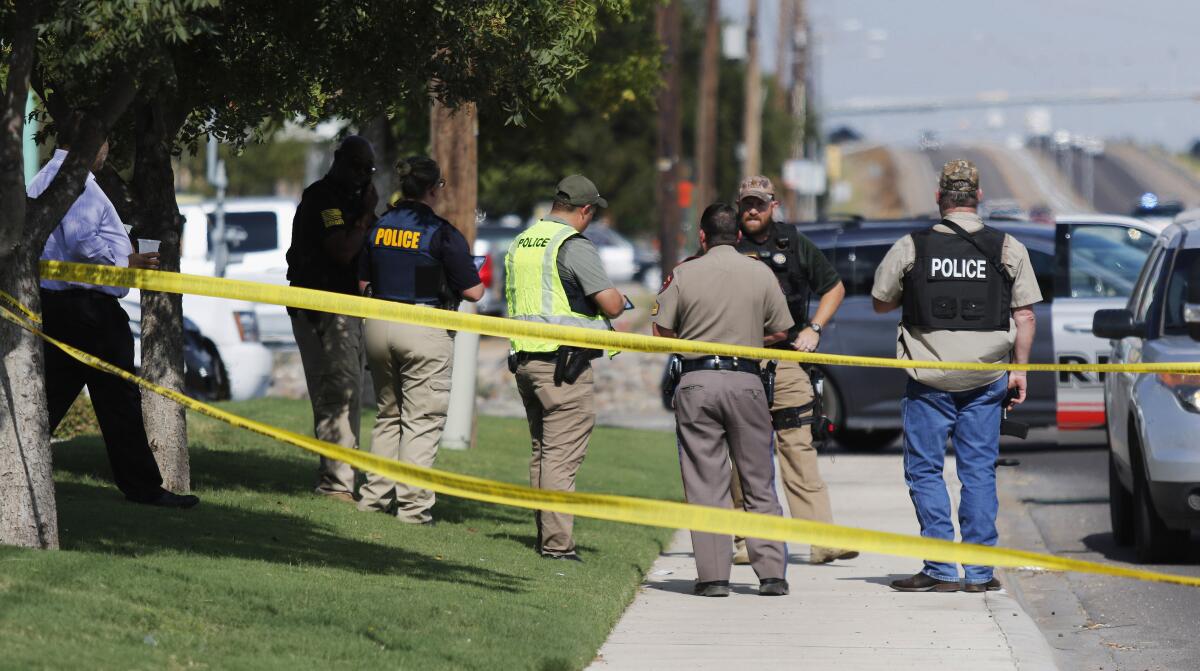Opinion: We analyzed 53 years of mass shooting data. Attacks aren’t just increasing, they’re getting deadlier

- Share via
If you look at mass shootings over time, two things are alarmingly clear: The attacks are becoming far more frequent, and they are getting deadlier.
We’ve studied every public mass shooting since 1966 for a project funded by the National Institute of Justice, the research arm of the U.S. Department of Justice. Our research spans more than 50 years, yet 20% of the 164 cases in our database occurred in the last five years. More than half of the shootings have occurred since 2000 and 33% since 2010. The deadliest years yet were 2017 and 2018, and this year is shaping up to rival them, with at least 60 killed in mass shootings, 38 of them in the last five weeks.
The death count per shooting is also rising dramatically. Sixteen of the 20 most deadly mass shootings in modern history occurred in the last 20 years, eight of them in the last five years, including the 2017 Las Vegas shooting that claimed an unprecedented 58 lives.
For decades, the toll of mass shootings has risen steadily. During the 1970s, mass shootings claimed an average of 5.7 lives per year. In the 1980s, the average rose to 14. In the 1990s it reached 21; in the 2000s, 23.5. This decade has seen a far sharper rise. Today, the average is 51 deaths per year.
Mass shootings still represent just one-half of 1% of the more than 14,000 firearm-caused homicides per year in the United States, but while the number of homicides overall has declined in recent years, the number of mass shootings continues to surge.
There is no universally accepted definition of a mass shooting. But for our research at the Violence Project, we use the Congressional Research Service definition, which includes any event in which four or more victims (not including the shooter) are murdered in a public location with firearms. By that standard, the mass shooting in the Texas cities of Odessa and Midland on Saturday afternoon, in which seven people plus the shooter died, was the sixth this year.
A different definition with fewer deaths or the death of the shooter included in the total body count would yield many more mass shootings. But six is six too many, and enough for us now to conclude that, contrary to previous estimates, mass shootings are increasing in frequency.
If the attacks seem to follow a macabre pattern, that is not surprising. Mass shooting memes spread by diffusion. First, innovators like the Columbine High School killers provide a blueprint for early adopters to follow. Each new shooting normalizes the process and encourages new participants to join in.
The validation process is self-sustaining. Like genre conventions in movies and pop culture, mass shooters today are conforming to expectations of what mass shooters do. They post their pet ideologies on the internet, use similar-style assault rifles, and try to top the death count of those who came before.
We too are conforming. Politicians and civic leaders offer thoughts and prayers. The media feature the victims’ families, cover the funerals and probe the killers’ backgrounds. And we try to “harden” targets, putting children through rituals of lockdown drills and equipping them with bulletproof backpacks for school.
Studies estimate that in the aftermath of their attacks, mass killers receive approximately $75 million in free media coverage, a level professional athletes and Hollywood actors would envy. For men who feel angry, alienated and anonymous, the incentives to perform are appealing. And bigger body counts mean bigger headlines. One recently thwarted shooter posted that, “A good 100 kills would be nice,” and another wanted to “break a world record.”
And, as we wrote in another L.A. Times op-ed last month, contagion is only one part of the complex mass shooter story. At a time when childhood trauma is rising, more young men are angry or in suicidal crisis, and access to highly lethal firearms has never been easier. Lots of research has gone into copycat suicides and how to prevent them. We should treat mass shootings the same. In this case, suicide and homicide are different sides of the same coin.
Mass shootings are growing in number and impact but they are not an inevitable fact of American life. They demand action. We must challenge any rhetoric that endorses hate and violence, change the blueprint we are handing our children, and step-by-step, rewrite the U.S. violence script.
James Densley is a sociologist and professor of criminal justice at Metropolitan State University. Jillian Peterson is a psychologist and professor of criminology and criminal justice at Hamline University. They run the Violence Project.
More to Read
A cure for the common opinion
Get thought-provoking perspectives with our weekly newsletter.
You may occasionally receive promotional content from the Los Angeles Times.










